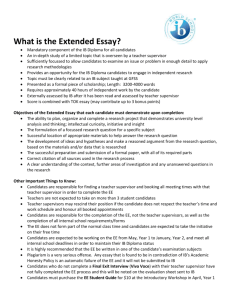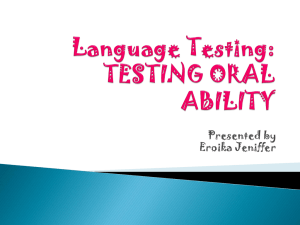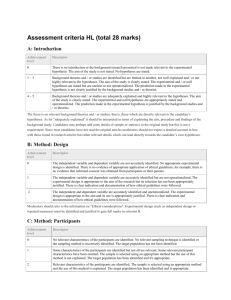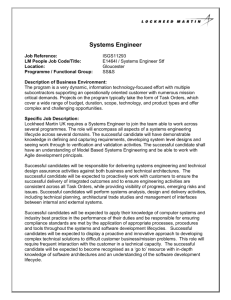SL Grading Rubric - AP Psychology Community
advertisement
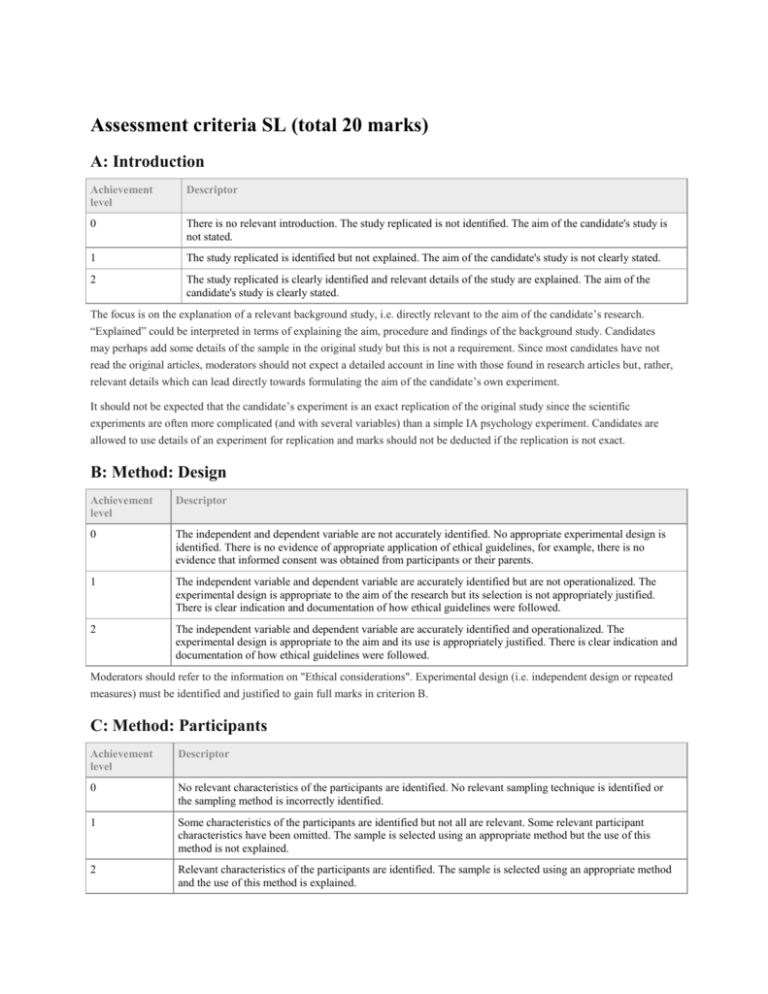
Assessment criteria SL (total 20 marks) A: Introduction Achievement level Descriptor 0 There is no relevant introduction. The study replicated is not identified. The aim of the candidate's study is not stated. 1 The study replicated is identified but not explained. The aim of the candidate's study is not clearly stated. 2 The study replicated is clearly identified and relevant details of the study are explained. The aim of the candidate's study is clearly stated. The focus is on the explanation of a relevant background study, i.e. directly relevant to the aim of the candidate’s research. “Explained” could be interpreted in terms of explaining the aim, procedure and findings of the background study. Candidates may perhaps add some details of the sample in the original study but this is not a requirement. Since most candidates have not read the original articles, moderators should not expect a detailed account in line with those found in research articles but, rather, relevant details which can lead directly towards formulating the aim of the candidate’s own experiment. It should not be expected that the candidate’s experiment is an exact replication of the original study since the scientific experiments are often more complicated (and with several variables) than a simple IA psychology experiment. Candidates are allowed to use details of an experiment for replication and marks should not be deducted if the replication is not exact. B: Method: Design Achievement level Descriptor 0 The independent and dependent variable are not accurately identified. No appropriate experimental design is identified. There is no evidence of appropriate application of ethical guidelines, for example, there is no evidence that informed consent was obtained from participants or their parents. 1 The independent variable and dependent variable are accurately identified but are not operationalized. The experimental design is appropriate to the aim of the research but its selection is not appropriately justified. There is clear indication and documentation of how ethical guidelines were followed. 2 The independent variable and dependent variable are accurately identified and operationalized. The experimental design is appropriate to the aim and its use is appropriately justified. There is clear indication and documentation of how ethical guidelines were followed. Moderators should refer to the information on "Ethical considerations". Experimental design (i.e. independent design or repeated measures) must be identified and justified to gain full marks in criterion B. C: Method: Participants Achievement level Descriptor 0 No relevant characteristics of the participants are identified. No relevant sampling technique is identified or the sampling method is incorrectly identified. 1 Some characteristics of the participants are identified but not all are relevant. Some relevant participant characteristics have been omitted. The sample is selected using an appropriate method but the use of this method is not explained. 2 Relevant characteristics of the participants are identified. The sample is selected using an appropriate method and the use of this method is explained. Relevant characteristics of the participants could be age range, sex, nationality, whether or not they are psychology students, or characteristics that are important in the experiment such as the participants in a Stroop experiment not suffering from colour blindness. All of these characteristics could be seen as relevant. Some candidates will also mention the type of school (public or private). This is acceptable but it is not a requirement and candidates should not be penalized for not addressing this. In the past, some candidates have mentioned socio-economic status but many do not and this is not a requirement. In IB schools with students from many socio-economic groups it would not be possible to make a statement about socio-economic status and there may be ethical issues involved in this also. Moderators should take into consideration that most participants in the experiments are fellow students and moderators should use their judgement about what would be reasonable to expect as relevant characteristics of the sample in an experiment of this kind. Moderators should note that SL candidates are not expected to identify the target population. The assessment criteria refer to ‘selection of an appropriate sampling method and explanation of its use’. This can be understood as ‘justified’ or that candidates can simply explain how they sampled according to the chosen sampling method. Both ways are acceptable. D: Method: Procedure Achievement level Descriptor 0 No relevant procedural information is included. The information provided does not allow replication. There are no details of how the ethical guidelines were applied. 1 The procedural information is relevant but not clearly described, so that the study is not easily replicable. Details of how the ethical guidelines were applied are included. Necessary materials have not been included and referenced in the appendices. 2 The procedural information is relevant and clearly described, so that the study is easily replicable. Details of how the ethical guidelines were applied are included. Necessary materials have been included and referenced in the appendices. Moderators should refer to the information on "Ethical considerations". It is sufficient for candidates to make a list of relevant material in the materials section before the procedure and to make a reference to those materials in the appendices. In that case there is no need to reference them again in the procedure section. If the requirements of criterion D are met satisfactorily in either way, full marks should be awarded. E: Results Achievement level Descriptor 0 There are no results or the results are irrelevant to the stated aim of the candidate's experimental study. Descriptive statistics have not been applied to the data. There is no graphing of data. 1-2 Results are stated and accurate and reflect the aim of the research. Descriptive statistics (one measure of central tendency and one measure of dispersion) are applied to the data, but their use is not explained. The graph of results is not accurate, is unclear or is not sufficiently related to the aim of the study. Results are not presented in both words and tabular form. 3-4 Results are clearly stated and accurate and reflect the aim of the research. Appropriate descriptive statistics (one measure of central tendency and one measure of dispersion) are applied to the data and their use is explained. The graph of results is accurate, clear and directly relevant to the aim of the study. Results are presented in both words and tabular form. The assessment criteria explain that descriptive statistics (one measure of central tendency or one measure of dispersion) are applied to the data. However, it may be that candidates have nominal data. In that case descriptive statistics could be percentages or totals and it would be impossible to use a measure of dispersion. Candidates should not be penalized for not including a measure of dispersion when the data is nominal. The guide states that the use of descriptive statistics should be explained. This could be interpreted as ‘justified’ with reference to levels of measurement of the data or an explanation of how the descriptive statistics were applied to the data. Candidates should not be penalized if they don’t refer to levels of measurement of data in their explanation of the descriptive statistics. A clear graph and a clear table must be included in this section to obtain full marks. If the graph and table are not properly labelled then they are not clear. If the graph and / or table do not have a title but are clear and relevant to the aim of the study, one mark should be taken off in criterion E. F: Discussion Achievement level Descriptor 0 There is no discussion or it is irrelevant to the aim of the research. 1-2 Discussion of the results is very superficial. The findings of the candidate's experimental study are not compared to those of the study being replicated. Limitations of the design and procedure are not accurately identified. No modifications are suggested and there is no conclusion. 3-4 Discussion of the results is not well developed. The findings of the candidate's experimental study are discussed with reference to the study being replicated. Some relevant limitations of the design and procedure have been identified, but a rigorous analysis of method is not achieved. Some modifications are suggested. The conclusion is appropriate. 5-6 Discussion of results is well developed (for example, differences in the results of calculations of central tendency and / or dispersion are explained). The findings of the candidate's experimental study are discussed with reference to the study being replicated. Limitations of the design and procedure are highly relevant and have been rigorously analysed. Modifications are suggested and ideas for further research are mentioned. The conclusion is appropriate. Discussion of results should include reference to original study and could include the results of the descriptive statistics. Candidates who have discussed their results in the results section instead of here should not be penalized. The important thing is that the candidate’s own statistical calculations are discussed in the report in a relevant manner. Candidates should compare their own results to the research mentioned in the introduction and with regard to the details they have mentioned there. The assessment criteria requires ‘modifications are suggested and ideas for further research are mentioned’ to obtain marks in the top range. If candidates suggest modifications of hypothetical future research, these should be accepted. If candidates suggest relevant modifications of their study and then give suggestions for research that could be conducted in the same area, this is also acceptable. G: Presentation Achievement level Descriptor 0 The report is not within the word limit of 1,000–1,500 words. Required sections of the report are missing, for example, no abstract is included. No references are provided. Appendices are missing or incomplete. 1 The report is within the word limit of 1,000–1,500 words. The report is complete but not in the required format. The reference for the study being replicated is cited but is not presented using a standard method of listing references. Appendices are not labelled appropriately and / or are not referenced in the body of the report. The abstract is poorly written and does not include a summary overview of the candidate's experimental study, including the results. 2 The report is within the word limit of 1,000–1,500 words. The report is complete and in the required format. The reference for the study being replicated is cited using a standard method of listing references. Appendices are labelled appropriately and are referenced in the body of the report. The abstract is clearly written and includes a summary overview of the candidate's experimental study, including the results. A reference must be provided in the introduction and / or in the discussion section. A standard reference method should be used consistently (for example, APA or MLA but examiners should not penalize candidates who do not use APA). If candidates do not apply secondary citation correctly in the report but use a standard reference method in their bibliography they should only lose one mark in criterion G. Calculation of the statistics (descriptive statistics) should be included in the appendices. Candidates may use calculators or online calculators to calculate but the calculation should be documented in the appendices, for example, with a screenshot if an online calculator is used. If this is not the case it will affect the marks awarded in criterion G. Ethical guidelines The following guidelines should be applied to all experimental studies. Any experimental study that creates anxiety, stress, pain or discomfort for participants must not be permitted. Any experimental study that involves unjustified deception, involuntary participation or invasion of privacy, including the inappropriate use of information technology (IT), e-mail and the Internet, must be avoided. There may be rare occasions when such infringements cannot be avoided, in which case the approval of other experienced psychologists should be sought before proceeding (moderators should contact the IB Assessment Centre for further guidance). All participants must be informed before commencing the experimental study that they have the right to withdraw at any time. Pressure must not be placed on any individual participant to continue with the investigation beyond this point. Each participant must be informed of the aims and objectives of the research and must be shown the results of the research. Young children should not be used as participants. Experimental studies involving children need the written consent of parent(s) or guardian(s). Candidates must ensure that parents are fully informed about the implications for children who take part in such research. Where an experimental study is conducted with children in a school, the written consent of the teachers concerned must also be obtained. Participants must be debriefed and given the right to withdraw their own personal data and responses. Anonymity for each participant must be guaranteed. Teachers and candidates must exercise the greatest sensitivity to local and international cultures. Candidates must avoid conducting research with any adult who is not in a fit state of mind and cannot respond freely and independently. If any participant shows stress and / or pain at any stage of an experimental study, the investigation must finish immediately, and the participant must be allowed to withdraw. Non-human animals must not be used for experimental study. All data collected must be kept in a confidential and responsible manner and not divulged to any other person. Candidates must regard it as their duty to monitor the ways in which their peers conduct research, and to encourage public re-evaluation of any research that contravenes these guidelines.

